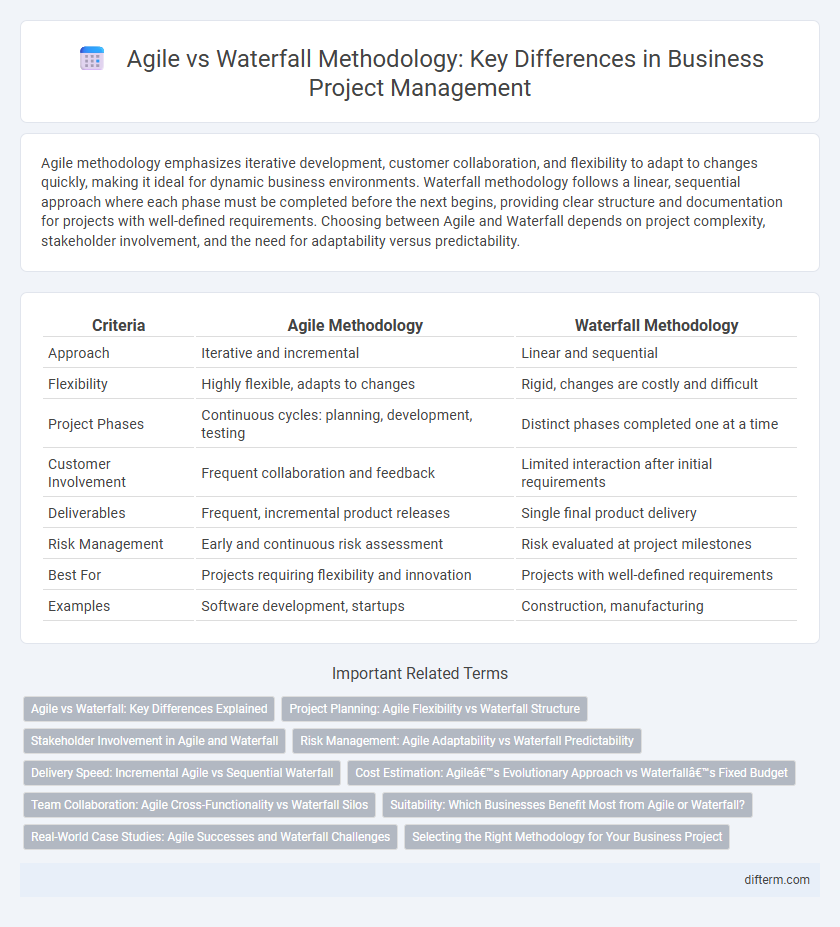Agile methodology emphasizes iterative development, customer collaboration, and flexibility to adapt to changes quickly, making it ideal for dynamic business environments. Waterfall methodology follows a linear, sequential approach where each phase must be completed before the next begins, providing clear structure and documentation for projects with well-defined requirements. Choosing between Agile and Waterfall depends on project complexity, stakeholder involvement, and the need for adaptability versus predictability.
Table of Comparison
| Criteria | Agile Methodology | Waterfall Methodology |
|---|---|---|
| Approach | Iterative and incremental | Linear and sequential |
| Flexibility | Highly flexible, adapts to changes | Rigid, changes are costly and difficult |
| Project Phases | Continuous cycles: planning, development, testing | Distinct phases completed one at a time |
| Customer Involvement | Frequent collaboration and feedback | Limited interaction after initial requirements |
| Deliverables | Frequent, incremental product releases | Single final product delivery |
| Risk Management | Early and continuous risk assessment | Risk evaluated at project milestones |
| Best For | Projects requiring flexibility and innovation | Projects with well-defined requirements |
| Examples | Software development, startups | Construction, manufacturing |
Agile vs Waterfall: Key Differences Explained
Agile methodology emphasizes iterative development, flexibility, and customer collaboration, enabling teams to adapt quickly to changing requirements and deliver incremental value. Waterfall methodology follows a linear, sequential approach with distinct phases, requiring comprehensive upfront planning and limited scope for changes once the project advances. Key differences include Agile's focus on continuous feedback and iterative progress versus Waterfall's structured, phase-driven process and fixed scope.
Project Planning: Agile Flexibility vs Waterfall Structure
Agile methodology emphasizes adaptive project planning with iterative cycles and continuous feedback, allowing teams to respond swiftly to changing requirements and deliver incremental value. Waterfall methodology relies on a linear, structured project planning process with clearly defined phases and documentation, making it ideal for projects with stable, well-understood scopes. Agile's flexibility fosters collaboration and rapid adjustments, while Waterfall's predictability supports thorough upfront planning and strict deadlines.
Stakeholder Involvement in Agile and Waterfall
Agile methodology emphasizes continuous stakeholder involvement through regular iterations and feedback loops, ensuring project adaptability and alignment with business goals. Waterfall methodology involves stakeholders primarily during the initial requirements gathering and final delivery phases, often limiting opportunities for mid-project adjustments. This distinction impacts project flexibility, with Agile fostering collaborative decision-making and Waterfall following a more linear, predetermined path.
Risk Management: Agile Adaptability vs Waterfall Predictability
Agile methodology enhances risk management through iterative development and continuous feedback, allowing teams to quickly identify and address issues early. Waterfall methodology offers predictable risk assessment by following a linear, sequential approach, which minimizes uncertainties during each defined phase. Agile's adaptability supports dynamic changes, while Waterfall emphasizes thorough upfront planning to mitigate risks before execution.
Delivery Speed: Incremental Agile vs Sequential Waterfall
Agile methodology accelerates delivery speed through its incremental approach, enabling continuous releases and rapid feedback integration, which reduces time-to-market. In contrast, Waterfall follows a sequential process with distinct phases, often resulting in longer delivery cycles due to the need to complete each stage before progressing. Businesses adopting Agile benefit from increased adaptability and faster value realization compared to the rigid, linear Waterfall model.
Cost Estimation: Agile’s Evolutionary Approach vs Waterfall’s Fixed Budget
Agile methodology offers a flexible cost estimation approach by accommodating changes and iterative developments, allowing budgets to evolve throughout the project lifecycle. In contrast, Waterfall methodology relies on a fixed budget established early in the project, based on detailed upfront requirements and a sequential process. Businesses leveraging Agile benefit from adaptive budgeting that can respond to shifting priorities, while Waterfall suits projects with well-defined scopes and stable cost expectations.
Team Collaboration: Agile Cross-Functionality vs Waterfall Silos
Agile methodology fosters team collaboration through cross-functional teams that integrate diverse skills, enabling rapid communication and iterative problem-solving. In contrast, Waterfall methodology often results in siloed departments where sequential handoffs limit interaction and delay feedback. Agile's emphasis on continuous collaboration accelerates project adaptation and innovation, whereas Waterfall's rigid structure may hinder responsiveness and team cohesion.
Suitability: Which Businesses Benefit Most from Agile or Waterfall?
Agile methodology suits businesses in dynamic industries such as technology, software development, and startups, where flexibility and rapid iteration are crucial for responding to changing customer needs and market trends. Waterfall methodology is ideal for industries with well-defined requirements and regulatory constraints, like construction, manufacturing, and healthcare, where sequential project phases ensure thorough documentation and compliance. Companies focusing on innovation and customer feedback benefit from Agile, while those requiring predictability and strict timelines find Waterfall more effective.
Real-World Case Studies: Agile Successes and Waterfall Challenges
Real-world case studies reveal Agile Methodology's success in enhancing project adaptability and client collaboration, leading to faster product releases and improved customer satisfaction. In contrast, Waterfall Methodology often faces challenges such as inflexibility in requirement changes and delayed issue detection, resulting in increased costs and missed deadlines. Industry examples like Spotify and Microsoft demonstrate Agile's effectiveness in dynamic environments, while traditional sectors like construction still rely heavily on Waterfall despite its limitations.
Selecting the Right Methodology for Your Business Project
Selecting the right methodology for your business project hinges on evaluating project scope, flexibility needs, and stakeholder engagement. Agile methodology offers iterative development with continuous feedback, ideal for dynamic projects requiring adaptability and frequent adjustments. Waterfall methodology suits projects with well-defined requirements and linear phases, providing structured timelines and clear deliverables.
Agile Methodology vs Waterfall Methodology Infographic

 difterm.com
difterm.com